RevOps vs Sales Ops: How Startups Can Structure Revenue for Growth
10/14/20255 min read


Pipeline feels lumpy. Handoffs leak. Forecasts slip. That’s not a sales problem—it’s an operating system problem. The real question isn’t, “Do we need Sales Ops?” It’s, “When do we centralize under RevOps so the entire revenue engine runs as one?”
By the end of this guide, you’ll understand the differences between Sales Ops and RevOps, know which structure fits your startup stage and GTM motion, and learn how to align teams for predictable, capital-efficient growth.
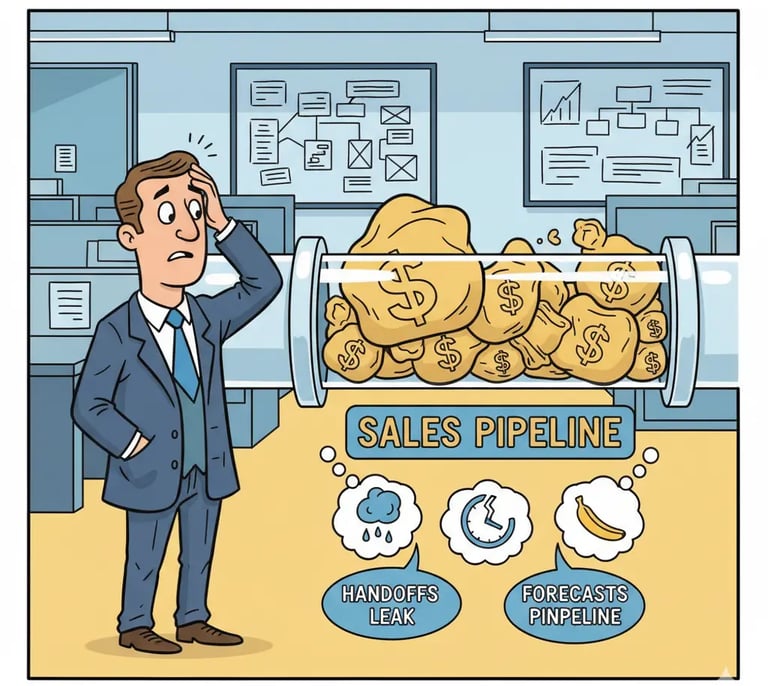

Sales Ops vs RevOps: The Core Difference
Sales Operations focuses on the sales team: territories, quotas, forecasting, pipeline hygiene, and tools. Its goal is rep productivity and predictable deal flow.
Revenue Operations (RevOps) goes broader, aligning Marketing, Sales, and Customer Success around a single data model, consistent processes, and unified metrics across the full customer lifecycle.
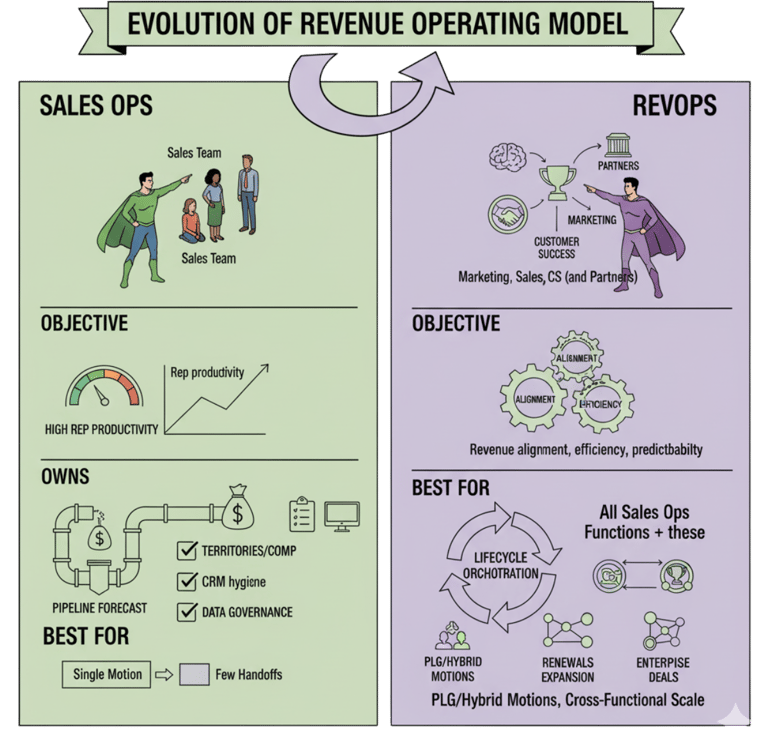

Why this matters now:
Buyers are omnichannel and expect seamless handoffs (McKinsey)
Efficiency rules: CAC payback and forecast accuracy drive decisions (Salesforce; Bessemer)
Product-led growth pushes usage signals into GTM workflows (OpenView
When to Start with Sales Ops
Sales Ops is the right fit when your startup is in early growth (pre- or just post-PMF) with a single GTM motion.
Key indicators:
CRM chaos: manual updates take more than 40% of reps’ time
Forecasting is guesswork, pipeline coverage inconsistent
Sales motion is repeatable but needs optimization
Ideal stage: $1M–$5M ARR, 5–15 sales reps, single sales-led or product-led motion.
Sales Ops focus areas:
Standardize CRM hygiene and pipeline tracking
Optimize territories, quotas, and comp plans
Build reliable forecasting models
Free reps to sell rather than handle admin
ROI potential: 15–20% increase in rep productivity, 20–30% improvement in forecast accuracy.
Pro tip: BriskFab’s Sales Audit & Training services help startups build these foundations systematically, ensuring processes scale with revenue without premature over-engineering.
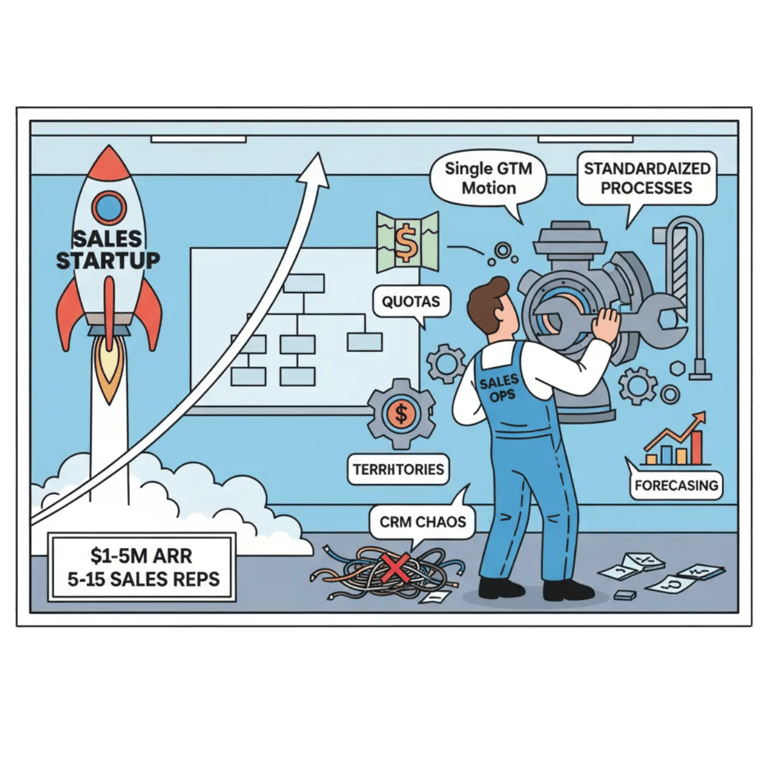

When to Adopt Revenue Operations
RevOps becomes essential once cross-functional complexity grows—multiple products, hybrid GTM, longer customer journeys, or recurring revenue models.
Indicators your startup may need RevOps:
Marketing, Sales, and CS constantly blame each other for revenue gaps
Data is fragmented across systems; no unified customer view
Tools are numerous, expensive, and underutilized
CAC payback slips despite improving sales efficiency
Forecasts vary by department; no single source of truth
Ideal stage: $5M+ ARR, scaling teams across Sales, Marketing, and CS, complex enterprise or multi-touchpoint sales cycles.
RevOps focus areas:
Unified definitions and SLAs across teams
Clean, consistent data architecture
Lifecycle orchestration from MQL→SQL→PQL→Renewals
Metrics that track full-funnel health: CAC, NRR, expansion, pipeline coverage
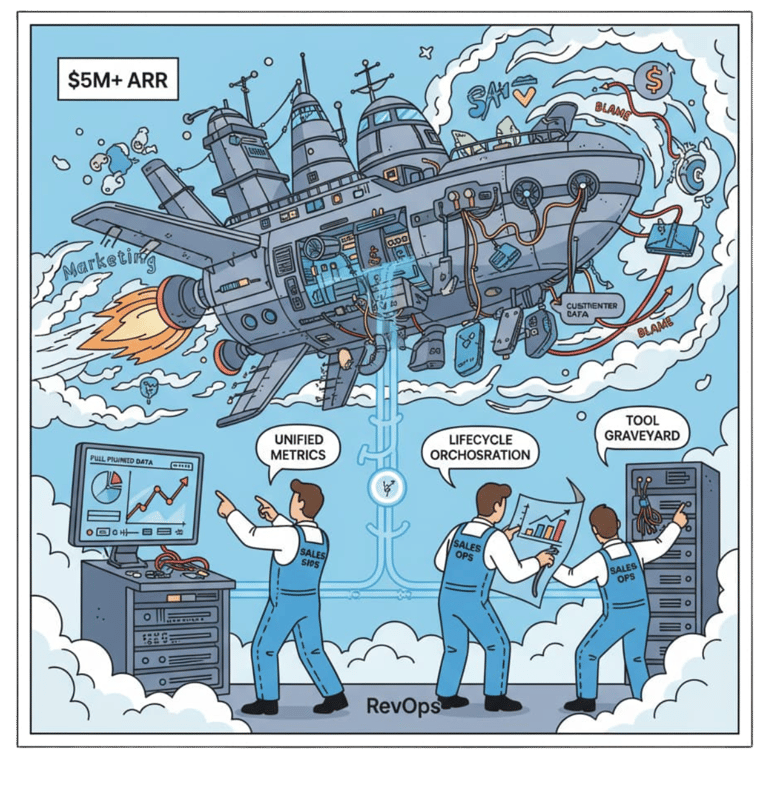

Business impact:
Forrester reports that companies aligning people, processes, and tech across revenue teams achieve 36% more revenue growth and 28% higher profitability
Boston Consulting Group found RevOps implementations deliver 200% increases in digital marketing ROI and 30% reductions in GTM expenses
SiriusDecisions notes that public companies with formal RevOps functions saw 71% higher stock performance
Note: Premature RevOps can create confusion, turf wars, and wasted spend. Focus first on Sales Ops foundations, then scale to RevOps when complexity demands it.
Matching Ops Structure to GTM Motion
Instead of hiring based on ARR alone, consider GTM complexity:
Sales Ops fits:
Single product, single ICP, transactional sales
Simple, short-cycle sales motion
RevOps fits:
Multiple products or tiers, multiple ICPs
PLG and sales motions together
Enterprise deals with long, multi-touch cycles
Data-backed insight: OpenView benchmarks show startups with three or more “complex motion” characteristics grow 2.3x faster when implementing RevOps versus Sales Ops alone.
Real-world examples:
Notion: Focused sales ops to scale PLG motion efficiently to $100M ARR
Gong: Adopted full RevOps at $20M ARR due to enterprise complexity
Five Warning Signals You’ve Outgrown Your Current Model
Forecasts are fiction – multiple teams report conflicting numbers
Attribution battles – no clarity on which channels drive revenue
Data maze – reporting takes days; dashboards inconsistent
Handoffs vanish – leads, accounts, and expansion opportunities disappear between teams
Tool graveyard – 10+ tools with <60% adoption, duplicate data everywhere
Rule of thumb: three or more signals = time to evaluate moving from Sales Ops to RevOps.
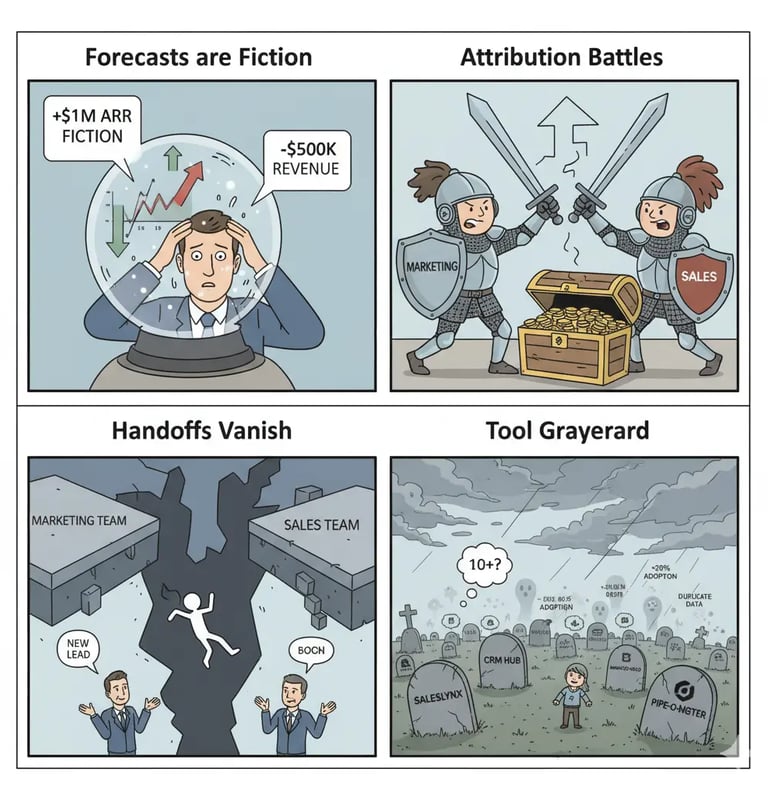

Universal Success Principles
Whether implementing Sales Ops or RevOps:
Customer-first mindset – processes, tools, and metrics should improve customer experience
Executive sponsorship – authority, budget, and air cover to drive cross-functional change
Clean data foundation – accurate measurement is essential for reliable decision-making
Documented, scalable processes – avoid tribal knowledge and single points of failure
Stage-appropriate metrics – track what matters now; expand KPIs as complexity grows
Startups often struggle not with tools, but with operating systems. BriskFab helps Seed–Series B teams:
Audit GTM processes and revenue leakage points
Build Sales Ops foundations or full RevOps infrastructure
Align teams on metrics, SLAs, and dashboards
Execute AI-powered GTM strategies for content, lead generation, and automation
The result: cleaner handoffs, tighter forecasts, optimized CAC, and higher NRR
Conclusion: Stage-Appropriate Ops Wins
Sales Ops optimizes the sales team. RevOps aligns the entire revenue lifecycle.
Pre-revenue to ~$100K ARR: If your team is tech-heavy and not sales-focused, leverage a vendor (like BriskFab) to build repeatable processes and validate your growth playbook.
$100K–$1M ARR: Start thinking about your first Sales Ops hire once your playbook is proven. Clean your data, standardize processes, and ensure early GTM alignment.
$1–5M ARR: Hire your first Sales Ops specialist, formalize processes, and start unifying reporting.
$5M+ ARR with friction: Audit for RevOps readiness, align GTM across teams, and centralize reporting to eliminate leaks.
The companies that win don’t necessarily have the biggest ops teams—they have the right ops infrastructure, built for their revenue motion at the right time.
Next step: Are your teams aligned, handoffs clean, and metrics trusted—or is revenue slipping through the cracks? BriskFab can map your reality and build the ops structure your growth stage actually demands.
Book a GTM + RevOps audit with BriskFab.
FAQ
Q1: What is the difference between Sales Ops and RevOps?
Sales Ops focuses on sales team efficiency and predictable pipeline, while RevOps aligns Marketing, Sales, and Customer Success to maximize revenue across the customer lifecycle.
Q2: When should a startup hire a RevOps team?
Typically at $10M+ ARR or when multiple teams influence revenue, sales cycles are multi-touch, and forecasting or CAC payback suffers due to cross-functional gaps.
Q3: Can a startup succeed with only Sales Ops?
Yes, for early growth stages ($1–10M ARR) with a single GTM motion. RevOps becomes essential as revenue complexity grows.
Q4: How does BriskFab help with revenue operations?
BriskFab audits GTM architecture, designs Sales Ops or RevOps structures, aligns metrics, and implements AI-powered systems for pipeline, content, and lead generation efficiency.
